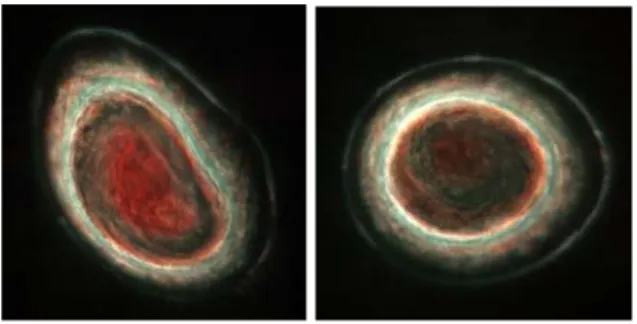Recent Juno-UVS Observations of Jupiter’s Auroras
Randy Gladstone (1,2), Thomas Greathouse (1), Maarten Versteeg (1), Vincent Hue (1), Joshua Kammer (1), Michael Davis (1), Jean-Claude Gérard (3), Denis Grodent (3), Bertrand Bonfond (3), Frederic Allegrini (1,2), Robert Ebert (1,2), Barry Mauk (4), Fran Bagenal (8), Scott Bolton (1) , Steven Levin (5) , and John Connerney (6,7)(1) Southwest Research Institute, San Antonio TX, (2) University of Texas at San Antonio, San Antonio TX
(rgladstone@swri.edu), (3) LPAP, STAR Institute, Université de Liège, Liège Belgium, (4) The Johns Hopkins University Applied Physics Laboratory, Laurel MD, (5) LASP, University of Colorado, Boulder CO, (6) Jet Propulsion Laboratory, Pasadena CA, (7) Space Research Corporation, Annapolis MD, (8) NASA Goddard Space Flight Center, Greenbelt MD
Abstract
Juno’s polar orbit provides excellent vantage points for studying Jupiter’s bright and highly-variable far-ultraviolet (FUV) auroral emissions [1-3]. The Juno mission is a little over halfway through its primary mission, and here we review some of the interesting results found so far by the Ultraviolet Spectrograph (UVS) instrument [4] during perijoves 1 and 3-21.
1. Introduction
Since reaching Jupiter on 4 July 2016 the Juno spacecraft has been in an elliptical polar orbit with a period of ~53.5 Earth days. While the orbit began in a nearly dawn-dusk orientation with a perijove near 4°N at a local time of 17:54, it is continuing to evolve (by precession of the line of apsides and the motion of Jupiter around the Sun) and is currently at a perijove near 22°N and a local time of 12:30. With the changing orbit, the view of the northern aurora during approach has become shorter, with better spatial resolution, but with generally higher background radiation. The view of the southern aurora during departure remains long with generally lower spatial resolution and background radiation as the spacecraft rises up over Jupiter’s south pole.
2. UVS observations
FUV observations of Jupiter’s auroras provide valuable insights into the fundamental processes of charged particle acceleration and the resulting currents in Jupiter's magnetosphere. Juno-UVS is an imaging spectrograph used to remotely sense Jupiter’s auroral morphology and brightness to provide context for in situ measurements by Juno’s particle instruments. The Juno-UVS bandpass (70-210 nm) includes FUV emissions from the H2 bands
and the H Lyman series which are the primary emissions produced in Jupiter’s auroras. Our primary
goal with UVS is to investigate the morphology of the FUV auroral emissions, particularly at local times not observable from Earth, to test different physical theories of the source of the emissions. Highlights of the results from these data will be presented here.
Figure 1: Average northern (left) and southern (right) auroral false-color maps observed by Juno-UVS.
Redder (bluer) colors indicate emissions which originate deeper (higher) in Jupiter’s thermosphere.
Acknowledgements
We gratefully acknowledge NASA support through contract NNM06AA75C to SwRI.
References
[1] Bolton, S.J., et al., The Juno mission. Space Sci. Rev., Vol. 213, pp. 5-37, 2017.
[2] Connerney, J.E.P., et al., Jupiter’s magnetosphere and aurorae observed by the Juno spacecraft during its first polar orbits, Science, Vol. 356, pp. 826-832, 2017.
[3] Bagenal, F., et al., Magnetospheric science objectives of the Juno mission, Space Sci. Rev., Vol. 213, pp. 219-287, 2017.
[4] Gladstone, G.R., et al., The ultraviolet spectrograph on NASA’s Juno mission, Space Sci. Rev., Vol. 213, pp. 447-473, 2017.
EPSC Abstracts
Vol. 13, EPSC-DPS2019-794-1, 2019 EPSC-DPS Joint Meeting 2019
c
